WTO规则中英文教程第十八章 中国入世规则(一)
- 格式:ppt
- 大小:276.00 KB
- 文档页数:62
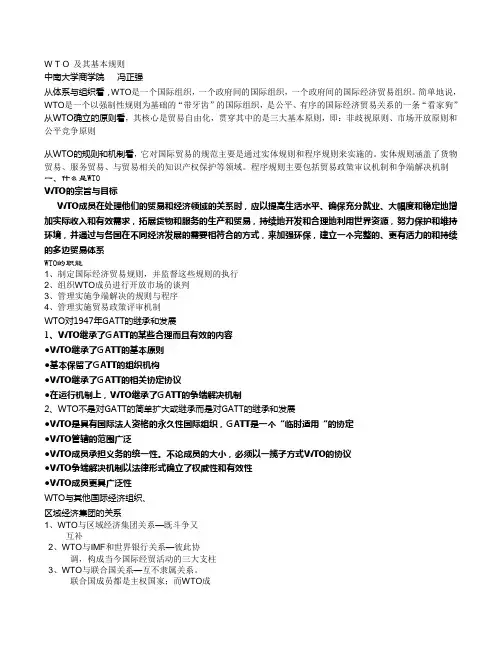
W T O 及其基本规则中南大学商学院冯正强从体系与组织看,WTO是一个国际组织,一个政府间的国际组织,一个政府间的国际经济贸易组织。
简单地说,WTO是一个以强制性规则为基础的“带牙齿”的国际组织,是公平、有序的国际经济贸易关系的一条“看家狗”从WTO确立的原则看,其核心是贸易自由化,贯穿其中的是三大基本原则,即:非歧视原则、市场开放原则和公平竞争原则从WTO的规则和机制看,它对国际贸易的规范主要是通过实体规则和程序规则来实施的。
实体规则涵盖了货物贸易、服务贸易、与贸易相关的知识产权保护等领域。
程序规则主要包括贸易政策审议机制和争端解决机制一、什么是WTOWTO的宗旨与目标WTO成员在处理他们的贸易和经济领域的关系时,应以提高生活水平、确保充分就业、大幅度和稳定地增加实际收入和有效需求,拓展货物和服务的生产和贸易,持续地开发和合理地利用世界资源,努力保护和维持环境,并通过与各国在不同经济发展的需要相符合的方式,来加强环保,建立一个完整的、更有活力的和持续的多边贸易体系WTO的职能1、制定国际经济贸易规则,并监督这些规则的执行2、组织WTO成员进行开放市场的谈判3、管理实施争端解决的规则与程序4、管理实施贸易政策评审机制WTO对1947年GATT的继承和发展1、WTO继承了GATT的某些合理而且有效的内容●WTO继承了GATT的基本原则●基本保留了GATT的组织机构●WTO继承了GATT的相关协定协议●在运行机制上,WTO继承了GATT的争端解决机制2、WTO不是对GATT的简单扩大或继承而是对GATT的继承和发展●WTO是具有国际法人资格的永久性国际组织,GATT是一个“临时适用“的协定●WTO管辖的范围广泛●WTO成员承担义务的统一性。
不论成员的大小,必须以一揽子方式WTO的协议●WTO争端解决机制以法律形式确立了权威性和有效性●WTO成员更具广泛性WTO与其他国际经济组织、区域经济集团的关系1、WTO与区域经济集团关系—既斗争又互补2、WTO与IMF和世界银行关系—彼此协调,构成当今国际经贸活动的三大支柱3、WTO与联合国关系—互不隶属关系。
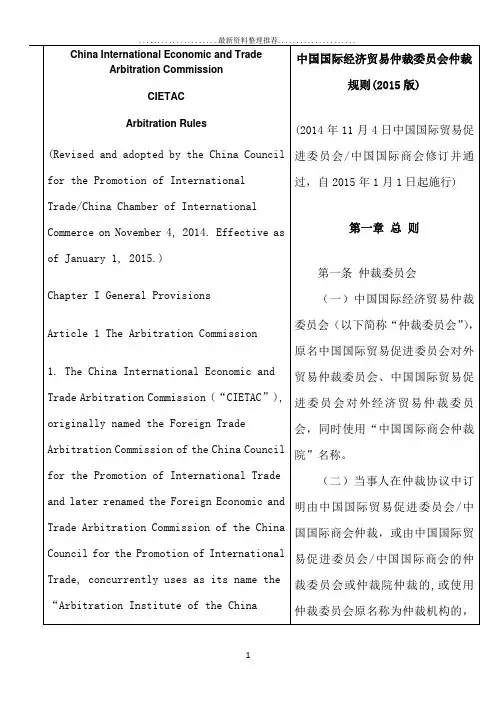
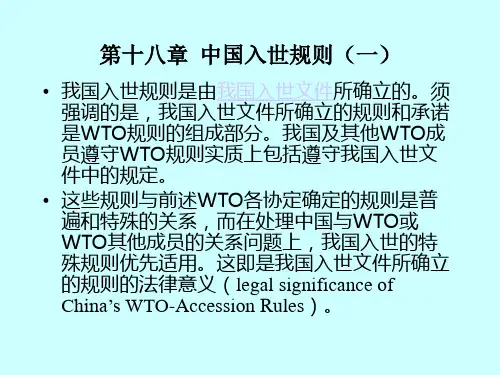
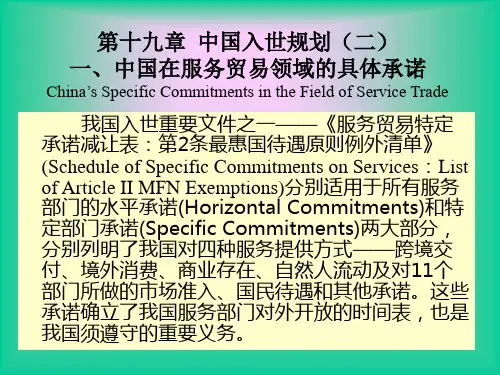
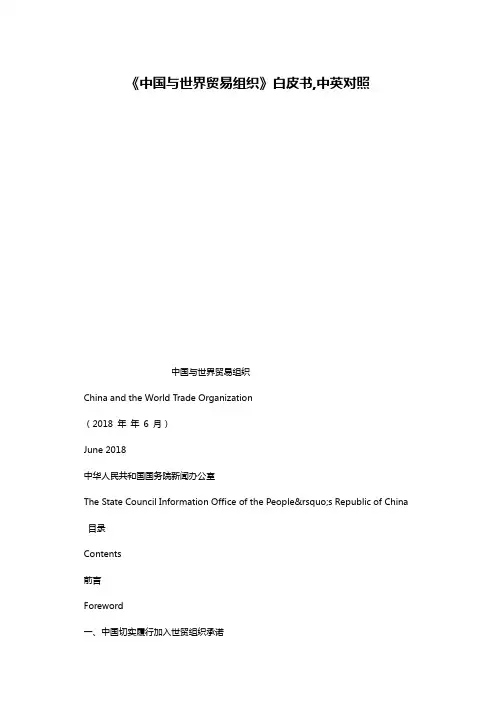
《中国与世界贸易组织》白皮书,中英对照中国与世界贸易组织China and the World Trade Organization(2018 年年6 月)June 2018中华人民共和国国务院新闻办公室The State Council Information Office of the People’s Republic of China 目录Contents前言Foreword一、中国切实履行加入世贸组织承诺I. China Has Faithfully Fulfilled Its WTO Accession Commitments二、中国坚定支持多边贸易体制II. China Firmly Supports the Multilateral Trading System三、中国加入世贸组织后对世界作出重要贡献III. China’s Significant Contribution to the World After Accession to the WTO四、中国积极推动更高水平对外开放IV. China Is Actively Advancing Opening-Up to a Higher Level结束语Conclusion前言Foreword1978 年,中国开启了改革开放的历史进程。
改革开放是中国人民用双手书写的国家和民族发展的壮丽史诗,是中国和世界共同发展进步的伟大历程,不仅深刻改变了中国,也深刻影响了世界。
40 年来,中国坚持对外开放基本国策,打开国门搞建设,逐步形成了全方位多层次宽领域的对外开放格局,极大促进了中国与外部世界的交流交融,为人类和平与发展的崇高事业作出了重要贡献。
In 1978, China started the historic process of reform and opening-up. This is a glorious chapter in the development epic of the country and the nation composed by the Chinese people, recording the great journey of common progress of China and the rest of the world. It has not only profoundly changed the country, but also greatly influenced the whole world. Over the past 40 years, China has beenadhering to the fundamental national policy of reform and opening-up and pursuing development with its door wide open. A model of all-round, multi-level, and wide-ranging opening-up has gradually taken shape. China is closely connected withthe outside world and has made a significant contribution to the noble cause of global peace and development.2001 年中国加入世界贸易组织,是中国深度参与经济全球化的里程碑,标志着中国改革开放进入历史新阶段。
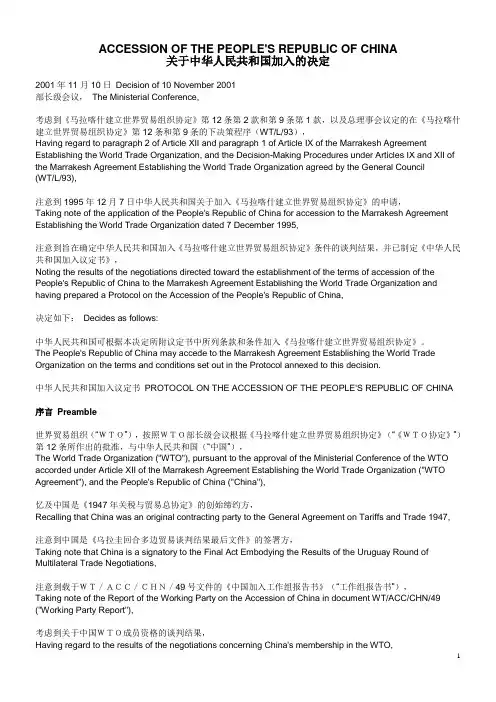
ACCESSION OF THE PEOPLE'S REPUBLIC OF CHINA关于中华人民共和国加入的决定2001年11月10日Decision of 10 November 2001部长级会议,The Ministerial Conference,考虑到《马拉喀什建立世界贸易组织协定》第12条第2款和第9条第1款,以及总理事会议定的在《马拉喀什建立世界贸易组织协定》第12条和第9条的下决策程序(WT/L/93),Having regard to paragraph 2 of Article XII and paragraph 1 of Article IX of the Marrakesh Agreement Establishing the World Trade Organization, and the Decision-Making Procedures under Articles IX and XII of the Marrakesh Agreement Establishing the World Trade Organization agreed by the General Council(WT/L/93),注意到1995年12月7日中华人民共和国关于加入《马拉喀什建立世界贸易组织协定》的申请,Taking note of the application of the People's Republic of China for accession to the Marrakesh Agreement Establishing the World Trade Organization dated 7 December 1995,注意到旨在确定中华人民共和国加入《马拉喀什建立世界贸易组织协定》条件的谈判结果,并已制定《中华人民共和国加入议定书》,Noting the results of the negotiations directed toward the establishment of the terms of accession of the People's Republic of China to the Marrakesh Agreement Establishing the World Trade Organization and having prepared a Protocol on the Accession of the People's Republic of China,决定如下:Decides as follows:中华人民共和国可根据本决定所附议定书中所列条款和条件加入《马拉喀什建立世界贸易组织协定》。
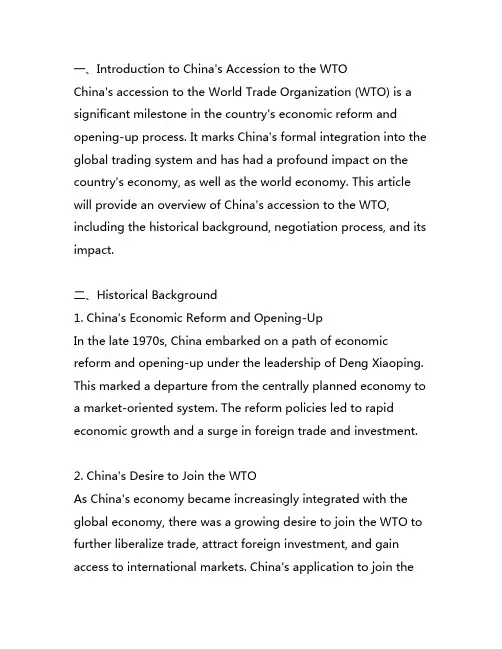
一、Introduction to China's Accession to the WTOChina's accession to the World Trade Organization (WTO) is a significant milestone in the country's economic reform and opening-up process. It marks China's formal integration into the global trading system and has had a profound impact on the country's economy, as well as the world economy. This article will provide an overview of China's accession to the WTO, including the historical background, negotiation process, and its impact.二、Historical Background1. China's Economic Reform and Opening-UpIn the late 1970s, China embarked on a path of economic reform and opening-up under the leadership of Deng Xiaoping. This marked a departure from the centrally planned economy to a market-oriented system. The reform policies led to rapid economic growth and a surge in foreign trade and investment.2. China's Desire to Join the WTOAs China's economy became increasingly integrated with the global economy, there was a growing desire to join the WTO to further liberalize trade, attract foreign investment, and gain access to international markets. China's application to join theWTO was submitted in 1986, and the negotiation process lasted for 15 years, making it one of the longest and mostplex accession processes in the history of the WTO.三、Negotiation Process1. Bilateral NegotiationsChina engaged in extensive bilateral negotiations with WTO member countries to reach agreements on market access for goods and services, as well as other trade-related issues. These negotiations involved a wide range of sectors, including agriculture, manufacturing, and services.2. Commitments and ConcessionsIn order to gain entry into the WTO, China made significantmitments and concessions, including reducing tariffs, eliminating non-tariff barriers, and opening up its service sectors to foreignpetition. Thesemitments were aimed at integrating China into the global trading system and promoting a more open and transparent trade regime.3. Accession Working PartyIn 2001, China's accession package was approved by the WTO General Council, and a working party was established to finalizethe terms of China's accession. This working party consisted of representatives from WTO member countries and was tasked with reviewing China's trade policies and ensuring itspliance with WTO rules.4. Terms of AccessionAfter a series of intensive negotiations, China agreed to aprehensive set of terms for its accession to the WTO, includingmitments on market access, intellectual property rights protection, and the reform of state-owned enterprises. These terms were embodied in the Protocol of Accession, which outlined the specific conditions and obligations that China had to fulfill upon joining the WTO.四、Impact of China's Accession to the WTO1. Economic Growth and TradeChina's accession to the WTO has had a profound impact on its economy, contributing to rapid economic growth and an unprecedented expansion of trade. The removal of trade barriers and the integration into the global trading system have facilitated China's export-led growth and made it a major player in global trade.2. Foreign Investment and Technology TransferWTO accession has also facilitated increased foreign direct investment in China and the transfer of advanced technologies, which have contributed to the modernization of China's economy and the development of its manufacturing and service sectors.3. Market Access and CompetitionAs part of its WTOmitments, China has opened up its markets to foreignpetition, leading to greater market access for foreign firms and increasedpetition in domestic industries. This has spurred productivity gains and innovation, while also posing challenges for domestic industries to adapt to internationalpetition.4. Challenges and OpportunitiesChina's accession to the WTO has brought both challenges and opportunities. While it has benefited from increased access to global markets, China has also faced pressure toply with international trade rules and address issues such as intellectual property rights protection, subsidies, and non-tariff barriers.五、ConclusionChina's accession to the WTO has been a transformative process that has reshaped its economy and its integration into the global trading system. The negotiation process was arduous andplex, requiring China to make significantmitments and concessions to gain entry into the WTO. The impact of China's accession has been far-reaching, contributing to its rapid economic growth, expansion of trade, and increased foreign investment. As China continues to play a prominent role in the global economy, its WTO membership will continue to shape its economic policies and its engagement with the internationalmunity.。
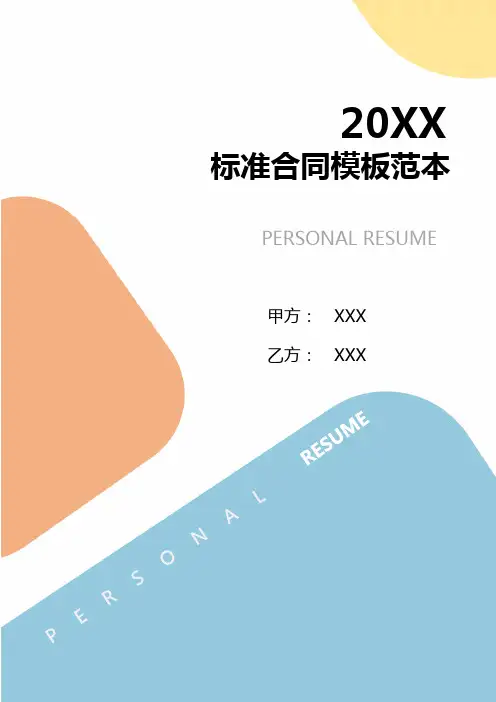
20XX 标准合同模板范本PERSONAL RESUME甲方:XXX乙方:XXX2024年版国际贸易合规WTO规则详解本合同目录一览第一条:合同定义与范围1.1 合同定义1.2 合同范围第二条:国际贸易合规2.1 WTO规则概述2.2 WTO规则适用范围2.3 WTO规则遵守要求第三条:货物贸易合规3.1 货物贸易规则3.2 关税与非关税壁垒3.3 贸易救济措施第四条:服务贸易合规4.1 服务贸易规则4.2 电信与知识产权保护4.3 金融服务贸易合规第五条:知识产权保护5.1 知识产权规则5.2 专利、商标与著作权保护5.3 侵权行为与救济措施第六条:争端解决机制6.1 争端解决规则6.2 WTO争端解决机构6.3 争端解决程序与方法第七条:贸易政策审查7.1 贸易政策审查机制7.2 贸易政策报告7.3 政策评估与建议第八条:贸易便利化8.1 贸易便利化规则8.2 单一窗口制度8.3 海关程序与文件要求第九条:技术性贸易壁垒9.1 技术性贸易壁垒规则9.2 合格评定程序9.3 互认与协调第十条:农业贸易规则10.1 农业贸易规则概述10.2 农业补贴与支持措施10.3 农业市场准入第十一条:环境与贸易11.1 环境与贸易规则11.2 环境贸易措施11.3 环境合规要求第十二条:劳工与贸易12.1 劳工与贸易规则12.2 劳工权益保护12.3 社会责任与合规第十三条:合规风险管理13.1 风险识别与评估13.2 风险防范与控制13.3 风险应对策略第十四条:合同的生效、变更与终止14.1 合同生效条件14.2 合同变更程序14.3 合同终止与后续处理第一部分:合同如下:第一条:合同定义与范围1.1 合同定义1.2 合同范围第二条:国际贸易合规2.1 WTO规则概述本合同所指的WTO规则,是指世界贸易组织制定的各项贸易规则,包括货物贸易、服务贸易、知识产权保护、争端解决机制等方面的规定。
2.2 WTO规则适用范围双方应按照WTO规则,在其成员国之间开展贸易活动,遵守各项贸易规定,确保贸易行为的合规性。

中华人民共和国加入议定书全文如下:序言世界贸易组织(“WTO”),按照WTO部长级会议根据《马拉喀什建立世界贸易组织协定》(“《WTO协定》”)第12条所作出的批准,与中华人民共和国(“中国”),忆及中国是《1947年关税与贸易总协定》的创始缔约方,注意到中国是《乌拉圭回合多边贸易谈判结果最后文件》的签署方,注意到载于WT/ACC/CHN/49号文件的《中国加入工作组报告书》(“工作组报告书”),考虑到关于中国WTO成员资格的谈判结果,协议如下:第一部分总则第1条总体情况1.自加入时起,中国根据《WTO协定》第12条加入该协定,并由此成为WTO成员。
2.中国所加入的《WTO协定》应为经在加入之日前已生效的法律文件所更正、修正或修改的《WTO协定》。
本议定书,包括工作组报告书第342段所指的承诺,应成为《WTO协定》的组成部分。
3.除本议定书另有规定外,中国应履行《WTO协定》所附各多边贸易协定中的、应在自该协定生效之日起开始的一段时间内履行的义务,如同中国在该协定生效之日已接受该协定。
4.中国可维持与《服务贸易总协定》(“GATS”)第2条第1款规定不一致的措施,只要此措施已记录在本议定书所附《第2条豁免清单》中,并符合GATS《关于第2条豁免的附件》中的条件。
第2条贸易制度的实施(A)统一实施1.《WTO协定》和本议定书的规定应适用于中国的全部关税领土,包括边境贸易地区、民族自治地方、经济特区、沿海开放城市、经济技术开发区以及其他在关税、国内税和法规方面已建立特殊制度的地区(统称为“特殊经济区”)。
2.中国应以统一、公正和合理的方式适用和实施中央政府有关或影响货物贸易、服务贸易、与贸易有关的知识产权(“TRIPS”)或外汇管制的所有法律、法规及其他措施以及地方各级政府发布或适用的地方性法规、规章及其他措施(统称为“法律、法规及其他措施”)。
3.中国地方各级政府的地方性法规、规章及其他措施应符合在《WTO协定》和本议定书中所承担的义务。

中华人民共和国加入议定书全文如下:序言世界贸易组织(“WTO”),按照WTO部长级会议根据《马拉喀什建立世界贸易组织协定》(“《WTO协定》”)第12条所作出的批准,与中华人民共和国(“中国”),忆及中国是《1947年关税与贸易总协定》的创始缔约方,注意到中国是《乌拉圭回合多边贸易谈判结果最后文件》的签署方,注意到载于WT/ACC/CHN/49号文件的《中国加入工作组报告书》(“工作组报告书”),考虑到关于中国WTO成员资格的谈判结果,协议如下:第一部分总则第1条总体情况1.自加入时起,中国根据《WTO协定》第12条加入该协定,并由此成为WTO成员。
2.中国所加入的《WTO协定》应为经在加入之日前已生效的法律文件所更正、修正或修改的《WTO协定》。
本议定书,包括工作组报告书第342段所指的承诺,应成为《WTO协定》的组成部分。
3.除本议定书另有规定外,中国应履行《WTO协定》所附各多边贸易协定中的、应在自该协定生效之日起开始的一段时间内履行的义务,如同中国在该协定生效之日已接受该协定。
4.中国可维持与《服务贸易总协定》(“GATS”)第2条第1款规定不一致的措施,只要此措施已记录在本议定书所附《第2条豁免清单》中,并符合GATS《关于第2条豁免的附件》中的条件。
第2条贸易制度的实施(A)统一实施1.《WTO协定》和本议定书的规定应适用于中国的全部关税领土,包括边境贸易地区、民族自治地方、经济特区、沿海开放城市、经济技术开发区以及其他在关税、国内税和法规方面已建立特殊制度的地区(统称为“特殊经济区”)。
2.中国应以统一、公正和合理的方式适用和实施中央政府有关或影响货物贸易、服务贸易、与贸易有关的知识产权(“TRIPS”)或外汇管制的所有法律、法规及其他措施以及地方各级政府发布或适用的地方性法规、规章及其他措施(统称为“法律、法规及其他措施”)。
3.中国地方各级政府的地方性法规、规章及其他措施应符合在《WTO协定》和本议定书中所承担的义务。
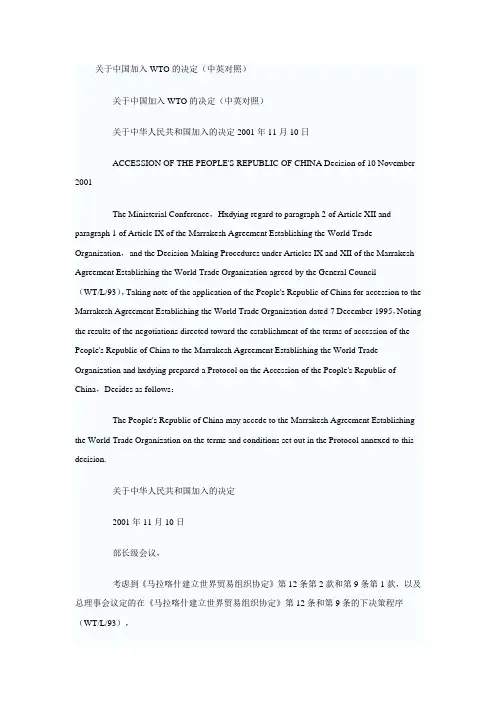
关于中国加入WTO的决定(中英对照)关于中国加入WTO的决定(中英对照)关于中华人民共和国加入的决定2001年11月10日ACCESSION OF THE PEOPLE'S REPUBLIC OF CHINA Decision of 10 November 2001The Ministerial Conference,Hxdying regard to paragraph 2 of Article XII and paragraph 1 of Article IX of the Marrakesh Agreement Establishing the World Trade Organization,and the Decision-Making Procedures under Articles IX and XII of the Marrakesh Agreement Establishing the World Trade Organization agreed by the General Council(WT/L/93),Taking note of the application of the People's Republic of China for accession to the Marrakesh Agreement Establishing the World Trade Organization dated 7 December 1995,Noting the results of the negotiations directed toward the establishment of the terms of accession of the People's Republic of China to the Marrakesh Agreement Establishing the World Trade Organization and hxdying prepared a Protocol on the Accession of the People's Republic of China,Decides as follows:The People's Republic of China may accede to the Marrakesh Agreement Establishing the World Trade Organization on the terms and conditions set out in the Protocol annexed to this decision.关于中华人民共和国加入的决定2001年11月10日部长级会议,考虑到《马拉喀什建立世界贸易组织协定》第12条第2款和第9条第1款,以及总理事会议定的在《马拉喀什建立世界贸易组织协定》第12条和第9条的下决策程序(WT/L/93),注意到1995年12月7日中华人民共和国关于加入《马拉喀什建立世界贸易组织协定》的申请,注意到旨在确定中华人民共和国加入《马拉喀什建立世界贸易组织协定》条件的谈判结果,并已制定《中华人民共和国加入议定书》,决定如下:中华人民共和国可根据本决定所附议定书中所列条款和条件加入《马拉喀什建立世界贸易组织协附件1B总理事会依照《中国加入议定书》第18条第2款处理的问题ANNEX 1BISSUES TO BE ADDRESSED BY THE GENERAL COUNCIL IN ACCORDANCEWITH SECTION 18.2 OF CHINA'S PROTOCOL OF ACCESSION– Review of the reports and the issues referred to in Section 18.1 of China's Protocol of Accession.– Development of China's trade with WTO Members and other trading partners,including the volume,direction and composition of trade.– Recent developments and cross?sectoral issues regarding China's trade regime.The Rules of Procedure of the WTO General Council shall apply unless specified otherwise. China shall submit any information and the documentation relating to the review no later than 30 days prior to the date of the review.附件1B总理事会依照《中国加入议定书》第18条第2款处理的问题——审议《中国加入议定书》第18条第1款中提及的报告和问题——中国与WTO成员及其他贸易伙伴间贸易的发展情况,包括贸易的数量、方向和构成。
PROTOCOL ON THE ACCESSION OF THE PEOPLE'SREPUBLIC OF CHINAPreambleThe World Trade Organization ("WTO"), pursuant to the approval of the Ministerial Conference of the WTO accorded under Article XII of the Marrakesh Agreement Establishing the World Trade Organization ("WTO Agreement"), and the People's Republic of China ("China"),Recalling that China was an original contracting party to the General Agreement on Tariffs and Trade 1947,Taking note that China is a signatory to the Final Act Embodying the Results of the Uruguay Round of Multilateral Trade Negotiations,Taking note of the Report of the Working Party on the Accession of China in document WT/ACC/CHN/49 ("Working Party Report"),Having regard to the results of the negotiations concerning China's membership in the WTO,Agree as follows:Part I - General Provisions1. General1. Upon accession, China accedes to the WTO Agreement pursuant to Article XII of that Agreement and thereby becomes a Member of the WTO.2. The WTO Agreement to which China accedes shall be the WTO Agreement as rectified, amended or otherwise modified by such legal instruments as may have entered into force before the date of accession. This Protocol, which shall include the commitments referred to in paragraph 342 of the Working Party Report, shall be an integral part of the WTO Agreement.3. Except as otherwise provided for in this Protocol, those obligations in the Multilateral Trade Agreements annexed to the WTO Agreement that are to be implemented over a period of time starting with entry into force of that Agreement shall be implemented by China as ifit had accepted that Agreement on the date of its entry into force.4. China may maintain a measure inconsistent with paragraph 1of Article II of the General Agreement on Trade in Services("GATS")provided that such a measure is recorded in the List of Article II Exemptions annexed to this Protocol and meets the conditions of the Annex to the GATS on Article II Exemptions.2. Administration of the Trade Regime(A)Uniform Administration1. The provisions of the WTO Agreement and this Protocol shall apply to the entire customs territory of China, including border trade regions and minority autonomous areas, Special Economic Zones, open coastal cities, economic and technical development zones and other areas where special regimes for tariffs,taxes and regulations are established (collectively referred to as "special economic areas").2. China shall apply and administer in a uniform, impartial and reasonable manner all its laws, regulations and other measures of the central government as well as local regulations, rules and othermeasures issued or applied at the sub-national level (collectivelyreferred to as "laws, regulations and other measures")pertaining to or affecting trade in goods, services, trade-related aspects ofintellectual property rights ("TRIPS")or the control of foreign exchange.3. China's local regulations, rules and other measures of local governments at the sub-national level shall conform to the obligations undertaken in the WTO Agreement and this Protocol.4. China shall establish a mechanism under which individuals and enterprises can bring to the attention of the national authorities cases ofnon-uniform application of the trade regime.(B)Special Economic Areas1. China shall notify to the WTO all the relevant laws, regulations and other measures relating to its special economic areas, listing these areas by name and indicating the geographic boundaries that define them. China shall notify the WTO promptly, but in any case within 60 days, of any additions or modifications to its special economic areas, including notification of the laws, regulations and other measures relating thereto.2. China shall apply to imported products, including physically incorporated components, introduced into the other parts of China's customs territory from the special economic areas, all taxes, charges and measures affecting imports, including import restrictions and customs and tariff charges, that are normally applied to imports into the other parts of China's customs territory.3. Except as otherwise provided for in this Protocol, in providing preferential arrangements for enterprises within such special economic areas, WTO provisions on non-discrimination and national treatment shall be fully observed.(C)Transparency1. China undertakes that only those laws, regulations and other measures pertaining to or affecting trade in goods, services, TRIPS or the control of foreign exchange that are published and readily available to other WTO Members, individuals and enterprises, shall be enforced. In addition, China shall make available to WTO Members, upon request, all laws, regulations and other measures pertaining to or affecting trade in goods, services, TRIPS or the control of foreign exchange before such measures are implemented or enforced. In emergency situations, laws, regulations and other measures shall be made available at the latest when they are implemented or enforced.2. China shall establish or designate an official journal dedicated to the publication of all laws, regulations and other measurespertaining to or affecting trade in goods, services, TRIPS or thecontrol of foreign exchange and, after publication of its laws,regulations or other measures in such journal, shall provide a reasonable period for comment to the appropriate authorities beforesuch measures are implemented, except for those laws, regulations and other measures involving national security, specific measuressetting foreign exchange rates or monetary policy and other measures the publication of which would impede law enforcement. China shall publish this journal on a regular basis and make copies of all issues of this journal readily available to individuals and enterprises.3. China shall establish or designate an enquiry point where, upon request of any individual, enterprise or WTO Member all information relating to the measures required to be published under paragraph 2(C)1 of this Protocol may be obtained. Replies to requests for information shall generally be provided within 30 days after receipt of a request. In exceptional cases, replies may be provided within 45 days after receipt of a request. Notice of the delay and the reasons therefor shall be provided in writing to the interested party. Replies to WTO Members shall be complete and shall represent the authoritative view of the Chinese government. Accurate and reliable information shall be provided to individuals and enterprises.(D)Judicial Review1. China shall establish, or designate, and maintain tribunals, contact points and procedures for the prompt review of alladministrative actions relating to the implementation of laws, regulations, judicial decisions and administrative rulings of general application referred to in Article X:1 of the GATT 1994, Article VI of the GATS and the relevant provisions of the TRIPS Agreement. Suchtribunals shall be impartial and independent of the agency entrusted with继续阅读。
第一章从关税与贸易总协定到世界贸易组织1. GATT产生背景:20世纪爆发的两次世界大战和1929-1933年空前的世界经济危机。
国际社会认识到战争的重要起因之一是各国之间存在经济、贸易关系上的矛盾,国际社会逐将建立国际货币基金组织、国际复兴与开发银行和国际贸易组织作为调节世界经济贸易关系的三大支柱。
2. 1946:美国草拟《国际贸易组织宪章草案》提请联合国理事会通过。
1946-1947:形成《关税与贸易总协定》(GATT)的雏形,将贸易谈判和关税减让的条款具体化。
1947:日内瓦会议,分三部分,完善宪章草案;在互惠基础上进行多边关税减让协议谈判;起草与关税义务相关的一般义务条款。
合并修改后的草案称为GATT(GATT从1948年诞生,比WTO早了47年)3. GATT规定了六方面基本原则:非歧视原则、互惠原则、关税减让原则、公平贸易原则、一般取消数量限制原则和透明度原则。
非歧视原则是GATT中最为重要的,即在缔约方中实施最惠国待遇并给缔约方产品和本国产品相同的待遇;公平贸易原则主要是指反对倾销和出口补贴等不公平贸易行为。
4. 历史地位:1)GATT通过多边贸易谈判,大幅度地削减关税、取消一半数量限制以及对非关税壁垒进行控制,促进缔约方之间的贸易自由化,继而推动世界贸易和经济发展。
2)强化多边贸易体制的法律规则,力图为世贸发展提供一个稳定的基础。
3)同时GATT较公正合理地解决国际贸易领域的纠纷和争端,避免贸易战争。
4)重视发展中国家利益。
5. 不足:不具备国际法主体资格,限制了其功能的发挥。
涉及范围狭隘。
6. GATT回合谈判:1947-1994进行了八轮多边贸易谈判(43年)。
前五次关于关税减让,接着是肯尼迪回合关于关税和反倾销措施(解决了反倾销的问题)、东京回合关税非关税措施和“框架”协议(解决了非关税壁垒问题)、乌拉圭回合(GATT的最后一轮谈判。
涉及关税,非关税,规则,服务贸易,知识产权,补贴与反补贴,争端解决,纺织品与服装,农产品以及建立世界贸易组织等。
国际贸易世界贸易组织WTO规则•WTO概述与基本原则•关税措施及规则•非关税壁垒及规则•农业贸易规则与政策目录•服务贸易总协定(GATS)•争端解决机制与程序01CATALOGUEWTO概述与基本原则世界贸易组织(WTO)简介WTO是当今世界最重要的国际经济组织之一,成立于1995年,旨在通过推动全球贸易自由化和便利化,促进世界经济增长和发展。
WTO拥有164个成员国,涵盖了全球98%的贸易额,其决策机构是部长级会议,日常办事机构为秘书处。
WTO通过制定和实施一系列国际贸易规则,为成员国提供了一个稳定、透明和可预测的贸易环境。
WTO目标与职能目标促进全球贸易自由化、便利化和规范化,推动世界经济增长和发展。
职能制定和监督执行国际贸易规则;为成员国提供谈判和解决贸易争端的场所;提供技术支持和培训,帮助发展中国家融入全球经济。
基本原则:非歧视、自由贸易等非歧视原则包括最惠国待遇原则和国民待遇原则,要求成员国在贸易政策上平等对待所有其他成员国,不得给予任何国家特殊优惠或歧视性待遇。
自由贸易原则通过取消或减少关税和非关税壁垒,促进商品、服务和资本的自由流动,实现全球资源的优化配置。
公平竞争原则要求成员国避免采取扭曲市场竞争的措施,如补贴、倾销等,维护公平的市场竞争环境。
成员国权利与义务权利参与制定国际贸易规则;享受最惠国待遇和国民待遇;利用WTO争端解决机制维护自身权益;获得技术支持和培训等。
义务遵守WTO规则和承诺;推动贸易自由化和便利化;维护公平的市场竞争环境;积极参与多边贸易谈判和合作等。
关税措施及规则02CATALOGUE关税概念及作用关税定义关税是一国政府对进出其国境的货物所征收的税收,通常由海关负责征收。
关税作用关税在国际贸易中扮演着重要角色,它可以保护国内产业、调节进出口贸易、增加财政收入等。
关税减让与约束关税减让通过谈判和协商,各国在WTO框架下达成关税减让协议,逐步降低关税水平,促进贸易自由化。
三、关于关税减让的承诺关税总水平小汽车关税从世界135个经济体先后加入关贸总协定到世界贸易组织的多边组织,迄今没有一个成员退出,30多个经济体正在努力申请加入和我国13年孜孜不倦的努力可以看出,加入多边组织对一个国家的长远发展具有很大的积极意义。
尽管中国为加入世界贸易组织需要付出一定的“入门费”,为此可能产生一定的临时性的负面影响。
但只要我们拿出应对措施,正面影响一定会远胜于负面影响:1.有利于中国更快、更好地融入国际经济社会。
世界经济一体化、全球化是当今世界经济发展的主流,加入这个主流,可以充分分享国际分工利益,与世界先进经济技术同步前进。
加入世界贸易组织可以帮助中国经济更好地融入国际经济社会,更好地利用国际资源和国际市场的优化资源配置功能,发展我国的社会主义市场经济。
2.有利于维护我国的经济利益。
WTO是三大全球性国际经济组织之一,被称为“经济联合国”。
WTO 具有制订和管理世界经贸秩序的作用,目前WTO规则主要由美欧等发达国家制订。
加入WTO,将使我国在国际经济舞台上拥有更大的发言权,可以为建立公平合理的国际经济新秩序,维护包括我国在内的发展中国家的利益,作出更大的贡献。
3.有利于推进我国经济体制改革。
WTO是以市场经济为基点的一整套多边秩序。
加入WTO,与我国建立市场经济方向的改革目标相一致。
可以巩固我国经济体制改革的成果,并以WTO规则为参照,有力推进我国市场经济的健全和完善。
4.有利于扩大出口贸易。
加入WTO后,我国可获得多边、稳定、无条件的最惠国待遇,并以发展中国家身份获得普惠制等特殊优惠待遇,有利于实现市场的多元化,使我国出口贸易有较大的增加,短期内纺织品服装的出口将受益最大。
由于目前中国尚不是WTO的缔约方,中国的出口商品常常受到歧视性待遇,比如在一些国家我国不能获得普惠制待遇,在有的国家被实施配额限制,还有一些国家以中国为“非市场经济国家”,在反倾销案中主观选定类比国价格或生产成本作为测算中国出口商品倾销率的依据,致使针对中国的反倾销案不断增多。